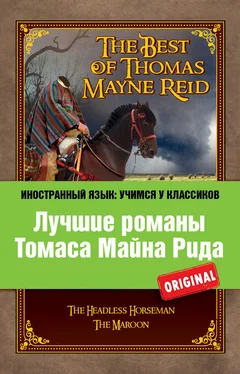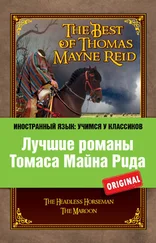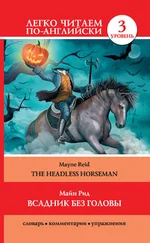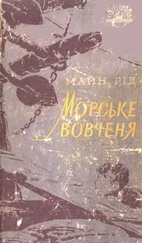He had learnt enough to know that this last promised a rich reward for its exploration.
It took him but a short time to regain it.
Nor did he lose any in following it up. He was too keenly impressed with its value; and with this idea urging him, he strode rapidly on, the mare following as before.
Once only did he make pause; at a point where the tracks of two horses converged with that he was following.
From this point the three coincided – at times parting and running parallel, for a score of yards or so, but again coming together and overlapping one another.
The horses were all shod – like that which carried the broken shoe – and the hunter only stopped to see what he could make out of the hoof marks. One was a “States horse;” the other a mustang – though a stallion of great size, and with a hoof almost as large as that of the American.
Zeb had his conjectures about both.
He did not stay to inquire which had gone first over the ground. That was as clear to him, as if he had been a spectator at their passing. The stallion had been in the lead, – how far Zeb could not exactly tell; but certainly some distance beyond that of companionship. The States horse had followed; and behind him, the roadster with the broken shoe – also an American.
All three had gone over the same ground, at separate times, and each by himself. This Zeb Stump could tell with as much ease and certainty, as one might read the index of a dial, or thermometer.
Whatever may have been in his thoughts, he said nothing, beyond giving utterance to the simple exclamation “Good!” and, with satisfaction stamped upon his features, he moved on, the old mare appearing to mock him by an imitative stride!
“Hyur they’ve seppurated,” he said, once again coming to a stop, and regarding the ground at his feet. “The stellyun an States hoss hev goed thegither – thet air they’ve tuk the same way. Broken-shoe hev strayed in a diffrent direkshun.”
“Wonder now what thet’s for?” he continued, after standing awhile to consider. “Durn me ef I iver seed sech perplexin’ sign! It ud puzzle ole Dan’l Boone [351] hisself.”
“Which on ’em shed I foller fust? Ef I go arter the two I know whar they’ll lead. They’re boun’ to kim up in thet puddle o’ blood. Let’s track up tother, and see whether he hev rud into the same procksimmuty! To the right abeout, ole gal, and keep clost ahint me – else ye may get lost in the chapparal, an the coyoats may make thur supper on yur tallow. Ho! ho! ho!”
With this apostrophe to his “critter,” ending in a laugh at the conceit of her “tallow,” the hunter turned off on the track of the third horse.
It led him along the edge of an extended tract of chapparal; which, following all three, he had approached at a point well known to him, as to the reader, – where it was parted by the open space already described.
The new trail skirted the timber only for a short distance. Two hundred yards from the embouchure of the avenue, it ran into it; and fifty paces further on Zeb came to a spot where the horse had stood tied to a tree.
Zeb saw that the animal had proceeded no further: for there was another set of tracks showing where it had returned to the prairie – though not by the same path.
The rider had gone beyond. The foot-marks of a man could be seen beyond – in the mud of a half-dry arroyo [352] – beside which the horse had been “hitched.”
Leaving his critter to occupy the “stall” where broken-shoe had for some time fretted himself, the old hunter glided off upon the footmarks of the dismounted rider.
He soon discovered two sets of them – one going – another coming back.
He followed the former.
He was not surprised at their bringing him out into the avenue – close to the pool of blood – by the coyotés long since licked dry.
He might have traced them right up to it, but for the hundreds of horse tracks that had trodden the ground like a sheep-pen.
But before going so far, he was stayed by the discovery of some fresh “sign” – too interesting to be carelessly examined. In a place where the underwood grew thick, he came upon a spot where a man had remained for some time. There was no turf, and the loose mould was baked hard and smooth, evidently by the sole of a boot or shoe.
There were prints of the same sole leading out towards the place of blood, and similar ones coming back again. But upon the branches of a tree between, Zeb Stump saw something that had escaped the eyes not only of the searchers, but of their guide Spangler – a scrap of paper, blackened and half-burnt – evidently the wadding of a discharged gun!
It was clinging to the twig of a locust-tree, impaled upon one of its spines!
The old hunter took it from the thorn to which, through rain and wind, it had adhered; spread it carefully across the palm of his horny hand; and read upon its smouched surface a name well known to him; which, with its concomitant title, bore the initials, “C.C.C.”
It was less surprise, than gratification, that showed itself on the countenance of Zeb Stump, as he deciphered the writing on the paper.
“That ere’s the backin’ o’ a letter,” muttered he. “Tells a goodish grist o’ story; more’n war wrote inside, I reck’n. Been used for the wad’ o’ a gun! Wal; sarves the cuss right, for rammin’ down a rifle ball wi’ a patchin’ o’ scurvy paper, i’stead o’ the proper an bessest thing, which air a bit o’ greased buckskin.”
“The writin’ air in a sheemale hand,” he continued, looking anew at the piece of paper. “Don’t signerfy for thet. It’s been sent to him all the same; an he’s hed it in purzeshun. It air somethin’ to be tuk care o’.”
So saying, he drew out a small skin wallet, which contained his tinder of “punk,” along with his flint and steel; and, after carefully stowing away the scrap of paper, he returned the sack to his pocket.
“Wal!” he went on in soliloquy, as he stood silently considering, “I kalkerlate as how this ole coon ’ll be able to unwind a good grist o’ this clue o’ mystery, tho’ thur be a bit o’ the thread broken hyur an thur, an a bit o’ a puzzle I can’t clurly understan’. The man who hev been murdered, whosomdiver he may be, war out thur by thet puddle o’ blood, an the man as did the deed, whosomdiver he be, war a stannin’ behint this locust-tree. But for them greenhorns, I mout a got more out o’ the sign. Now thur ain’t the ghost o’ a chance. They’ve tramped the hul place into a durnationed mess, cuvortin’ and caperin’ abeout.
“Wal, ’tair no use goin’ furrer thet way. The bessest thing now air to take the back track, if it air possable, an diskiver whar the hoss wi’ the broke shoe toted his rider arter he went back from this leetle bit o’ still-huntin’. Thurfor, ole Zeb’lon Stump, back ye go on the boot tracks!”
With this grotesque apostrophe to himself, he commenced retracing the footmarks that had guided him to the edge of the opening. Only in one or two places were the footprints at all distinct. But Zeb scarce cared for their guidance.
Having already noted that the man who made them had returned to the place where the horse had been left, he knew the back track would lead him there.
There was one place, however, where the two trails did not go over the same ground. There was a forking in the open list, through which the supposed murderer had made his way. It was caused by an obstruction, – a patch of impenetrable thicket. They met again, but not till that on which the hunter was returning straggled off into an open glade of considerable size.
Having become satisfied of this, Zeb looked around into the glade – for a time forsaking the footsteps of the pedestrian.
Читать дальше
Конец ознакомительного отрывка
Купить книгу











